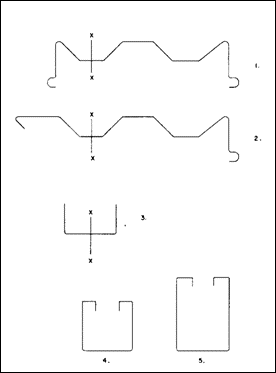Rolls are split where necessary to facilitate machining, grinding or for other changes, and also to allow for easy replacement of a roll piece that might be subject to extreme wear. In general, no roll pieces exceed 6” wide, meaning that wide shape rolls are made up in sections, sometimes even of different materials, according to the service requirement. In the case of wide panels where flats predominate, the flat roll pieces are composed of soft machine steel, the forming or working portions of tool steel.
Closely related to the subject of splitting rolls is the use of combination tooling. Combination tooling enables a manufacturer to produce several shapes with a minimal tooling outlay. Note the similarity of sections #1 and #2 on Figure #14. Combination tooling was used to produce these. The basic set was used for the shape to the right of line XX, and separate roll sets for the portions to the left of this line.
Looking at Section #3, splitting a set of channel rolls along line XX as shown, allows the forming of numerous widths simply by adding spacers at the split.
The shapes shown as #4 and #5 employ another type of combination roll arrangement involving split rolls with spacers for width in the first pass, a common set of bottom rolls, and two sets of top rolls in the subsequent passes.




